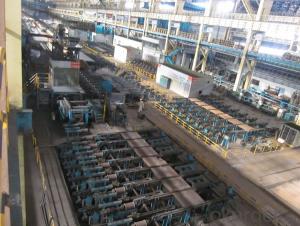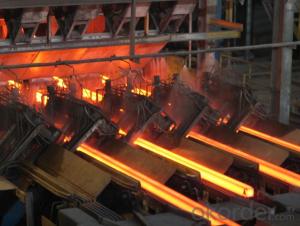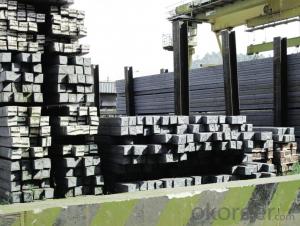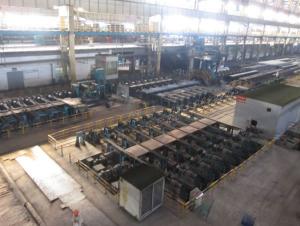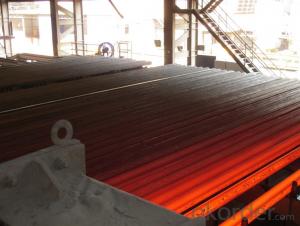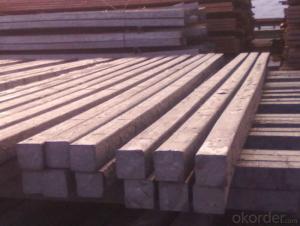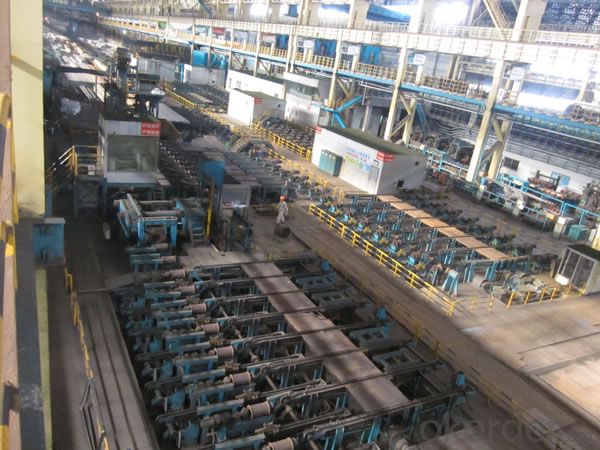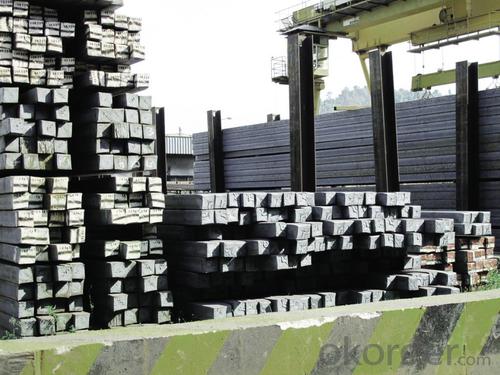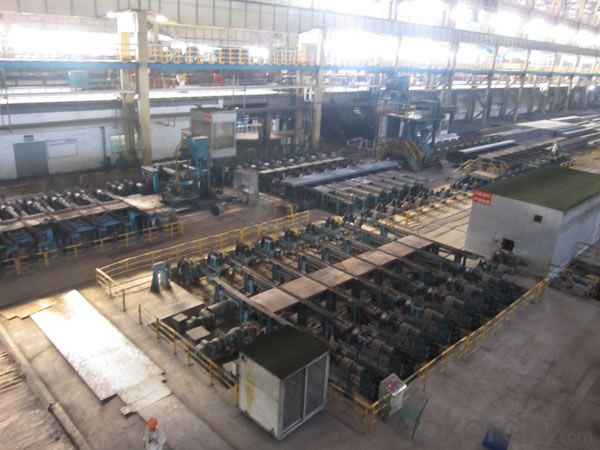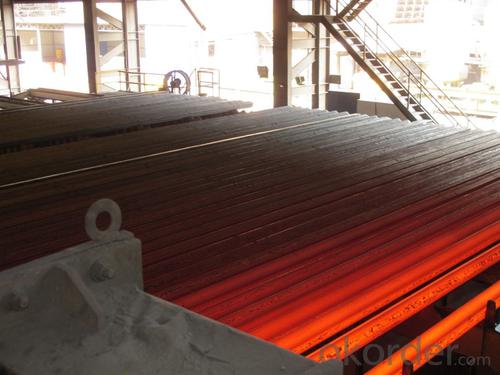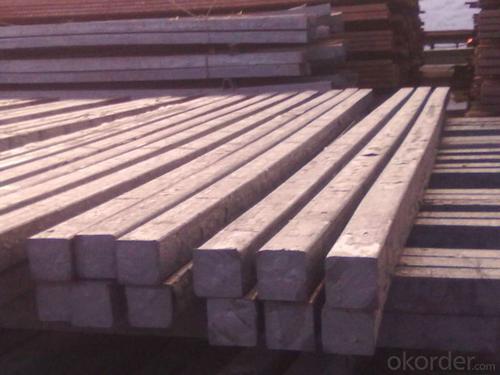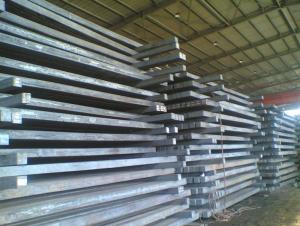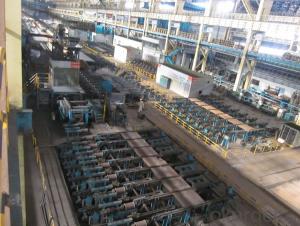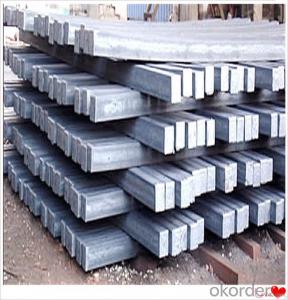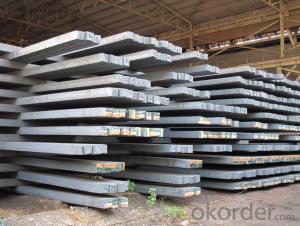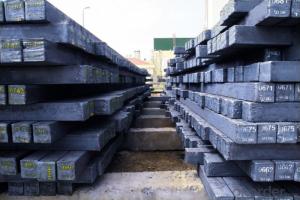Hot Rolled Square Steel Billet 3SP Standard 95mm
- Loading Port:
- Shanghai
- Payment Terms:
- TT OR LC
- Min Order Qty:
- 2000 m.t.
- Supply Capability:
- 10000 m.t./month
OKorder Service Pledge
OKorder Financial Service
You Might Also Like
Structure of Hot Rolled Square Steel Billet 3SP Standard 95mm
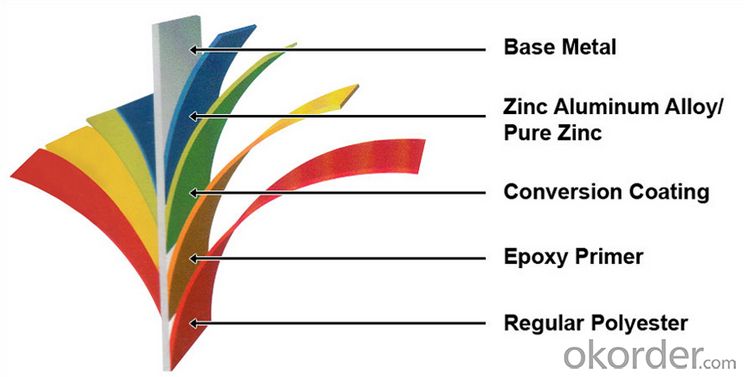
Description of Hot Rolled Square Steel Billet 3SP Standard 95mm
PPGI is made by cold rolled steel sheet and galvanized steel sheets as baseplate, through the surface pretreatment (degreasing, cleaning, chemical conversion processing), coated by the method of continuous coatings (roller coating method),
and after roasting and cooling. Zinc coating: Z60, Z80, Z100, Z120, Z180, Z275, G30, G60, G90
Alu-zinc coating: AZ60, AZ80, AZ100, AZ120, AZ180, G30, G60, G90
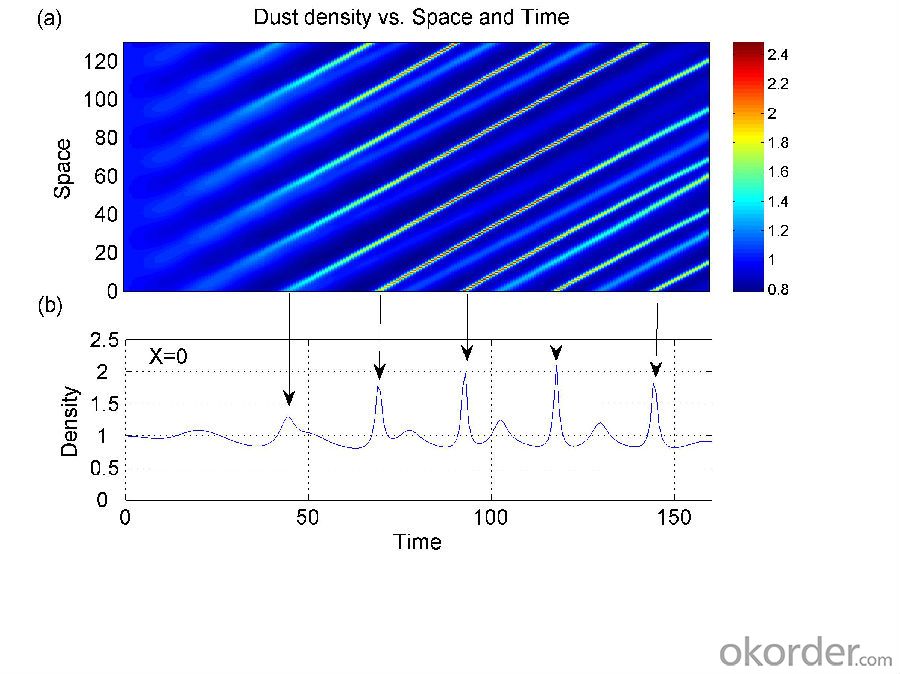
Main Feature of Hot Rolled Square Steel Billet 3SP Standard 95mm
1) Excellent corrosion resistance: The zinc layer provides a good protection of Pre-painted Galvanizeed Steel Sheet.
2) High heat resistance: The reflective surface of the material aids in efficiently reflecting the sunlight away and in turn reducing the amount of heat transmitted. The thermal reflectivity converts into energy savings.
3) Aesthetics: Pre-Painted Galvanized steel sheet is available in plethora of patterns and multiple sizes as per the requirements that given by our customers.
4) Versatility: can be used in the various areas.Standard seaworthy export packing: 3 layers of packing, inside is kraft paper, water plastic film is in the middle and outside GI steel sheet to be covered by steel strips with lock, with inner coil sleeve.
Applications of Hot Rolled Square Steel Billet 3SP Standard 95mm
1) Automotive bodies: filters, fuel tanks, etc.
2) Construction materials: roofings, welding pipes,
3) Electric and electronic appliances: computer cans, etc.
4) Steel cans: containers, etc.
5) Steel furniture: washing machines, refrigerators, microwaves, etc.
6) Drums
7) Office equipment: printer, recorders, etc.
8) Motors and transformers
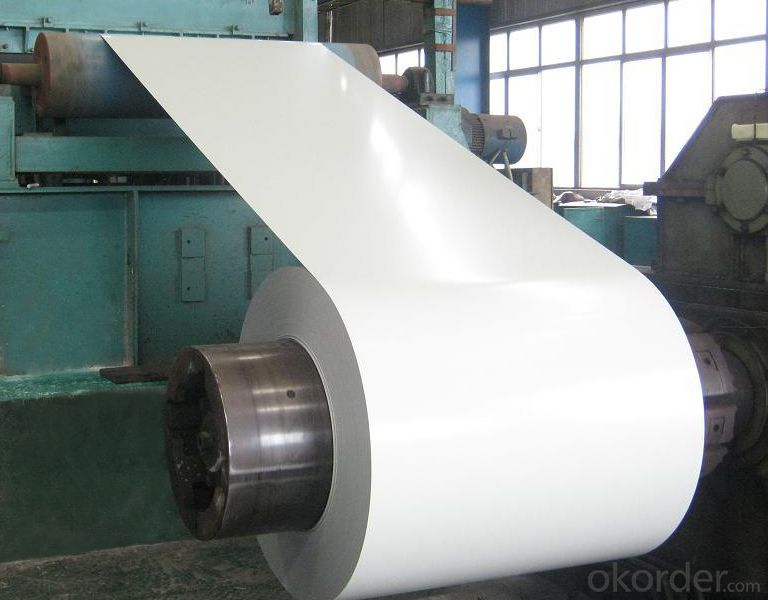
Specifications of Hot Rolled Square Steel Billet 3SP Standard 95mm
| Classified symbol | Yield Point Minimum N/mm2 | Tensile Strength Minimum | Elongation Minimum % | Application | ||||
| N/mm2 | Nominal Thickness mm (t) | |||||||
| JIS | Yogic | 0.25-0.4 | 0.4-0.6 | 0.6-1.0 | 1.0-1.6 | |||
| G3312 | specification | |||||||
| CGCC | CGCC | -205 | -270 | -20 | -21 | -24 | -24 | Commercial |
| CGCD | CGCD | --- | 270 | --- | 27 | 31 | 32 | Drawing |
| --- | CG340 | 245 | 340 | 20 | 20 | 20 | 20 | Structural |
| CGC400 | CG400 | 295 | 400 | 16 | 17 | 18 | 18 | Structural |
| CGC440 | CG440 | 335 | 440 | 14 | 15 | 16 | 18 | Structural |
| CGC490 | CG490 | 365 | 490 | 12 | 13 | 14 | 16 | Structural |
| CGC570 | CG570 | 560 | 570 | --- | --- | --- | --- | Structural |
| ASTM Designation | Yield Point Minimum | Tensile Strength Minimum | Elongation Minimum % | Application | Q/BQB 445-2004(China standard) | ASM A653/A653M | JISG 3312 | |
| ksi(MPa) | ksi(MPa) | TDC51D+Z | (CS TYPE A+Z) | CGCC | ||||
| A653(M)-99 CS TYPE A,B,C | --- | --- | --- | Commercial | TDC52D+Z | CGCD | ||
| A653(M)-99 FS | --- | --- | --- | Lock Forming | TS250GD+Z | (G250+Z) | - | |
| A653(M)-99 DS | --- | --- | --- | Drawing | TS300GS+Z | (G300+Z) | CGC 400 | |
| A653(M)-99 SS Grade33(230) | 33(230) | 45(310) | 20 | Structural | TS350GD+Z | (G350+Z) | CGC490 | |
| A653(M)-99 SS Grade37(255) | 37(255) | 52(360) | 18 | Structural | TS550GD+Z | (G550+Z) | CGC570 | |
| A653(M)-99 SS Grade40(275) | 40(275) | 55(380) | 16 | Structural | ||||
| A653(M)-99 SS Grade50(345) | 50(345) | 65(450) | 12 | Structural | ||||
| A653(M)-99 SS Grade80(550) | 80(550) | 82(570) | --- | Structural | ||||
FAQ of Hot Rolled Square Steel Billet 3SP Standard 95mm
We have organized several common questions for our clients,may help you sincerely:
1. How Can I Visit There?
Our company is located in Tianjin City, China, near Beijing. You can fly to Tianjin Airport Directly. All our clients, from home or aboard, are warmly welcome to visit us!
2. How Can I Get Some Sample?
We are honored to offer you sample.
3. Why choose CNBM?
1, ISO, BV, CE, SGS approved.
2, Competitive price and quality.
3, Efficient service team online for 24 hours.
4, Smooth production ability(50000tons/month) .
5, quick delivery and standard exporting package.
6, Flexible payment with T/T, L/C, Paypal, Kunlun bank, etc .
- Q: How are steel billets used in the manufacturing of industrial machinery?
- Steel billets are an essential component in the manufacturing of industrial machinery. These billets are semi-finished products that are produced through a process called continuous casting, where molten steel is poured into a mold to form a solid rectangular shape. Once the steel billets are formed, they undergo various processes to transform them into different components of industrial machinery. One common use of steel billets is in the production of machine parts such as gears, shafts, and axles. These components require high strength and durability to withstand the rigorous demands of industrial applications, and steel billets provide the necessary material properties. Steel billets are also used in the manufacturing of large structural components such as frames, bases, and supports for industrial machinery. These components need to be able to handle heavy loads and provide stability, and the use of steel billets ensures the necessary strength and rigidity. Furthermore, steel billets serve as raw material for forging, where they are heated and shaped using mechanical force to create complex shapes like crankshafts and connecting rods. The high malleability and ductility of steel billets make them ideal for forging, allowing manufacturers to produce intricate and precise components for industrial machinery. In addition, steel billets are often used in the production of specialized machinery, such as rolling mills and presses, which are used in various industrial processes. These machines require robust components that can withstand high temperatures, pressures, and forces, and steel billets provide the necessary strength and resilience. Overall, steel billets play a vital role in the manufacturing of industrial machinery as they provide the necessary strength, durability, and versatility required for producing various components and structures. Their use ensures the reliability and performance of industrial machinery in a wide range of applications.
- Q: How do steel billets contribute to the food processing industry?
- Steel billets contribute to the food processing industry in several ways. Firstly, steel billets are used to manufacture various machinery and equipment used in the food processing industry. For example, they are used to create conveyor belts, mixers, crushers, and packaging machines, among others. These machines play a crucial role in the processing, handling, and packaging of food products. Steel billets are also used to produce storage tanks and containers, which are essential for the safe and hygienic storage of food ingredients and finished products. These tanks are usually made of stainless steel, which is corrosion-resistant, durable, and easy to clean, ensuring that the food remains uncontaminated and of high quality. Furthermore, steel billets contribute to the construction of infrastructure in the food processing industry. They are used to build food processing plants, warehouses, and cold storage facilities. These structures provide the necessary environment for food processing, such as temperature control and proper ventilation, ensuring food safety and preservation. Additionally, steel billets are crucial for the transportation of food products. They are used to manufacture shipping containers, refrigerated trucks, and railway cars, which enable the efficient and safe transportation of food from one location to another. The strength and durability of steel ensure that the food products are protected during transit, preventing spoilage and contamination. Overall, steel billets are essential in the food processing industry as they contribute to the manufacturing of machinery, storage containers, infrastructure, and transportation systems. Their properties of strength, durability, and corrosion resistance make them ideal for ensuring food safety, quality, and efficiency in all stages of food processing.
- Q: How are steel billets used in the production of seamless pipes?
- Seamless pipes, which are manufactured without welding or seams, require steel billets as a fundamental component in their production process. Steel billets are rectangular-shaped solid pieces of steel that serve as the raw material for seamless pipe manufacturing. To produce seamless pipes, the initial step is melting steel in a furnace to obtain molten metal. This molten steel is then poured into molds to shape steel billets. These billets are then heated to a specific temperature and pierced using a piercing mill. This mill exerts both axial and radial forces, pushing a pointed mandrel through the center of the billet, resulting in a hollow tube or shell. Following the piercing process, the hollow tube is further elongated and reduced in diameter by a series of rolling mills. These mills apply a combination of rotational and compressive forces to shape the billet into the desired seamless pipe size. The seamless pipe undergoes continuous stretching and rolling until it reaches the desired length and diameter. The utilization of steel billets in the production of seamless pipes holds significant importance for several reasons. Firstly, the billets are crafted from high-quality steel, guaranteeing the strength and durability of the final product. Secondly, the uniformity and consistency of the billets allow for precise shaping and seamless pipe dimensions. Lastly, the solid structure of the billets enables them to withstand the intense forces and temperatures involved in the pipe manufacturing process. In conclusion, steel billets assume a crucial role in the production of seamless pipes. From being melted and molded into billets to being pierced, elongated, and rolled, these billets undergo a series of processes that transform them into high-quality seamless pipes. The use of steel billets ensures the integrity and reliability of seamless pipes, making them suitable for various industrial applications.
- Q: How do steel billets compare to other types of metal billets?
- Steel billets have several advantages over other types of metal billets. Firstly, steel is known for its exceptional strength and durability, making steel billets highly resistant to wear and tear. This makes them suitable for a wide range of applications, including construction, automotive, and manufacturing industries. Additionally, steel billets have excellent heat resistance, allowing them to withstand high temperatures without deforming or losing their structural integrity. This makes steel billets ideal for use in the production of components that are exposed to extreme heat, such as engine parts or industrial machinery. Moreover, steel billets offer versatility in terms of shape and size. They can be easily molded and formed into various shapes, enabling manufacturers to create complex and intricate designs. This flexibility makes steel billets preferred in industries where customized or intricate parts are required. Furthermore, steel billets are highly recyclable, making them a sustainable choice. The recycling process of steel requires significantly less energy compared to other metals, resulting in reduced carbon emissions and environmental impact. This aspect has led to an increased preference for steel billets in industries that prioritize sustainability and environmental responsibility. In summary, steel billets outperform other types of metal billets due to their exceptional strength, heat resistance, versatility, and recyclability. These properties make steel billets a preferred choice for numerous industries, offering a combination of durability, functionality, and environmental sustainability.
- Q: What are the different methods of steel billet surface grinding?
- There are several methods of steel billet surface grinding, including abrasive grinding, belt grinding, and centerless grinding.
- Q: What are the applications of steel billets?
- Steel billets are primarily used as raw material in the production of various steel products such as bars, rods, wire, and seamless tubes. They are also used in the manufacturing of components for automotive, construction, and machinery industries. Additionally, steel billets can be further processed to produce forgings, which are used in heavy machinery and equipment.
- Q: How do steel billets contribute to the aerospace industry?
- Steel billets are an essential component in the aerospace industry as they serve as the raw material for manufacturing various critical parts and components. These billets are used to produce high-strength and lightweight steel alloys that are crucial for aircraft structures, such as fuselages, wings, and landing gears. The superior strength and durability of steel billets allow for the construction of robust and reliable aircraft, ensuring safety and performance in demanding aerospace operations.
- Q: Iron type frequency furnace, billet 150, continuous casting billet between the hole, please help net friend to find the original, please ask non answer, not Xie, please mention, understand enough, please resume me
- 1: new furnace, new furnace lining contains more gas2: raw material no clean, no coincidence?3: melt protection? Temperature is not high, no refining and static?4:3 point, mold and traction to look for defects, mold cooling effect - water temperature - traction line and horizontal - traction process5: stop and pull
- Q: How are steel billets used in the production of wire rods and bars?
- Steel billets are an essential component in the production of wire rods and bars. These billets, which are semi-finished metal products, serve as the raw material for manufacturing various types of steel products. To begin the production process, steel billets are heated to a high temperature in a furnace, known as a reheat furnace, until they reach the desired temperature for rolling. Once heated, the billets are then passed through a series of rolling mills, where they undergo hot rolling. During the hot rolling process, the steel billets are gradually shaped into wire rods or bars by repeatedly passing them through a set of rollers. This process helps to reduce the billet's cross-sectional area and increase its length, resulting in the desired shape and dimensions of the wire rods or bars. After the initial rolling, the wire rods or bars may undergo additional processes, such as cooling, surface treatment, and further shaping or cutting, depending on the specific requirements of the end product. These additional steps help to improve the mechanical properties and surface finish of the wire rods or bars. Once the wire rods or bars have been processed, they can be used in a wide range of applications. Wire rods, for example, are commonly used in the production of wires, nails, fencing, and various types of reinforcement materials. Bars, on the other hand, are often utilized in construction, manufacturing machinery, automotive parts, and other structural applications. In summary, steel billets play a crucial role in the production of wire rods and bars. They are heated and then shaped through the hot rolling process, resulting in the desired dimensions and properties of the end product. These wire rods and bars are then used in various industries for different applications, contributing to the overall development and functionality of numerous products and structures.
- Q: What are the different methods of surface inspection for steel billets?
- Steel billets can undergo various methods of surface inspection to identify defects or irregularities. These include visual inspection, magnetic particle inspection, liquid penetrant inspection, ultrasonic inspection, and eddy current inspection. The simplest and most commonly used method is visual inspection, where inspectors visually examine the billet surface for visible defects such as cracks, pits, or irregularities. This method relies on the expertise and experience of the inspector. Magnetic particle inspection involves the use of magnetic fields and particles to detect surface and near-surface defects. By applying a magnetic field and particles to the billet surface, any defects attract particles, making them visible under proper lighting. Liquid penetrant inspection is another method used to detect surface defects. It involves applying a penetrant to the surface, which seeps into defects. After removing excess penetrant, a developer is applied to draw out the penetrant from the defects, making them visible. Ultrasonic inspection uses high-frequency sound waves to detect internal and surface defects. Sound waves are emitted into the billet using a transducer, and the reflected waves are analyzed to identify defects such as cracks, voids, and inclusions. Eddy current inspection is a non-destructive testing method that uses electromagnetic induction to detect surface defects. By moving a probe over the billet surface and passing an alternating current through it, any irregularities or defects disrupt the current flow, which can be detected and analyzed. Each method has its own advantages and limitations, and the choice depends on specific inspection requirements and constraints. Manufacturers utilize these methods to ensure the quality and reliability of steel billets before further processing or use in various applications.
Send your message to us
Hot Rolled Square Steel Billet 3SP Standard 95mm
- Loading Port:
- Shanghai
- Payment Terms:
- TT OR LC
- Min Order Qty:
- 2000 m.t.
- Supply Capability:
- 10000 m.t./month
OKorder Service Pledge
OKorder Financial Service
Similar products
Hot products
Hot Searches
Related keywords
